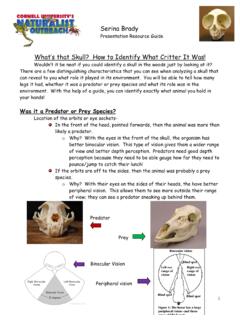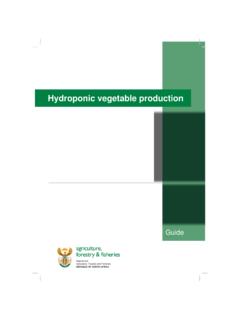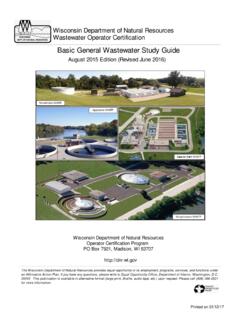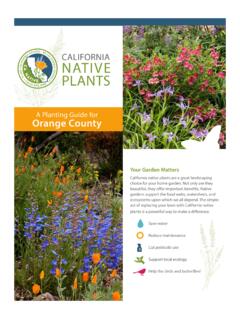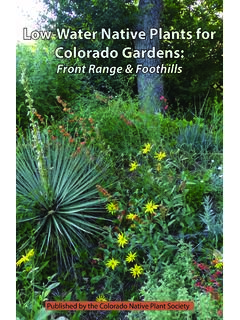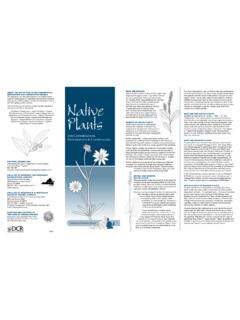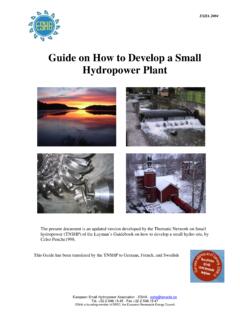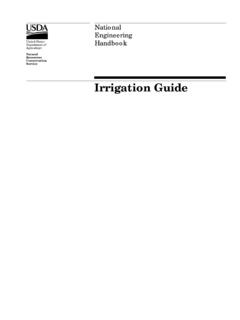Transcription of Virginia’s Native Plants
1 virginia Natural resource Education guide 1 virginia s Native Plants Native Plants are one of the Commonwealth s greatest natural resources with thousands of plant species Native to virginia , as well as various mosses and lichens. They also are part of our natural resource heritage in virginia . They provide the basis for much of our habitats and ecological communities throughout the state, serve as valuable tools to understand the natural world, and have intrinsic values as part of an ecosystem. A diversity of Native Plants ensures a high diversity of other organisms that use Plants communities for their food, shelter, and nesting because Plants are the basis of many of our food webs. Overview What is a Native plant? Put simply, a Native plant is one that occurs naturally ( not planted or brought by humans) in a given area. More refined definitions are provided by state, federal, and international organizations.
2 The non profit organization Wild Ones describes a Native plant species one that occurs naturally in a particular region, ecosystem and/or habitat and was present prior to European settlement. The National Park Service provides this description: " Native species are defined as all species that have occurred or now occur as a result of natural processes on lands designated as units of the national park system. Native species in a place are evolving in concert with each other." virginia s Department of Conservation and Recreation: Native species are those that occur in the region in which they evolved. Plants evolve over geologic time in response to physical and biotic processes characteristic of a region: the climate, soils, timing of rainfall, drought, and frost; and interactions with the other species inhabiting the local community. Thus Native Plants possess certain traits that make them uniquely adapted to local conditions, providing a practical and ecologically valuable alternative for landscaping, conservation and restoration projects, and as livestock forage.
3 In addition, Native Plants can match the finest cultivated Plants in beauty, while often surpassing non natives in ruggedness and resistance to drought, insects and disease. Figure 1. Sumac seed head. Provides winter food for birds and mammals. Photo by Emily Ford. virginia Natural resource Education guide 2 Why learn about virginia Native Plants ? Why teach about virginia Native Plants ? The diversity of Native Plants in virginia offers a rich opportunity to integrate subjects (science, English, social science, fine arts, and more) in an engaging way. Native Plants provide insight into cultural and historical heritage and opportunities to examine organism and ecosystem diversity in a healthy functioning system. virginia s remarkably diverse and unique assemblage is due to the state s variety of habitats, assorted geology, and physiographic differences which are divided into five distinct regions.
4 Some of our Plants have very specific life needs and can only grow under certain conditions, while others can thrive in a variety of habitats and communities. For example, the carnivorous sundew Plants survive in nutrient poor bogs where other Plants would perish because they have evolved sticky hairs to capture insects. The American mountain ash is rarely found at elevations below 3000 feet; it has evolved to live at higher elevations with poor, rocky soil. Many environmental factors (geology, soil type, slope of the land, and existing Plants ) determine what Native Plants can survive or thrive in a particular habitat. virginia s Native Plants range from ubiquitous species found statewide, [Chestnut Oak (Quercus montana), Red Oak (Quercus rubra), virginia creeper (Parthenocissus quinquefolia) or Common wood sorrel (Oxalis stricta)] to some Plants that are found only in a few counties!
5 These Plants are explored later in this chapter. Moss, or bryophytes, are abundant throughout our state. When compared to flowering Plants , little is known about their preferred habitats and ecosystems functions. Efforts are currently underway in virginia to include mosses in the Digital Atlas of virginia Flora: Mosses lend themselves to classroom learning well. They are easy to keep in the classroom, provide opportunities to study ecosystems on a small scale, and they are cute ! Figure 2. Prickly Pear cactus Opuntia humifusa. Photo by Emily Ford. Figure 3. Round leaved Sundew Drosera rotundifolia. Photo by Gary Fleming. virginia Science SOL Strand Connections Earth Resources , , , , , , , , virginia Natural resource Education guide 3 There are many ways to explore virginia Native plant species and their distributions. We can investigate geographic provinces, communities and habitat, elevation, plant shape or form, etc.
6 Read on to learn about Plants from the five physiographic regions of virginia . Physiographic Regions virginia has five geographic regions or physiographic provinces. Each of these regions has distinctive geology with a variety of soil types, temperature ranges, precipitation amounts, and soil moisture levels. Rainfall and temperature can vary across a geographic region, leading to a diversity of Plants in areas. Some Native Plants are restricted to a certain region while others can thrive in all the regions. Some Plants are adapted to live in brackish or salty water; thus they will only be found in the coastal plain and would never thrive in the Appalachian plateau. Appalachian Plateau Our westernmost region is the Appalachian plateau, a large, raised plain of eroded sedimentary rock. The elevation ranges from 2000 feet to about 4000 feet on ridge tops. The geology consists of sedimentary rocks, including coal.
7 The majority of this area is forested (80%); oak and oak hickory dominate the forests. In the Allegheny section of the plateau, Highland County is home to many species endemic to just the county [Drooping woodreed (Cinna latifolia) and Bog Goldenrod (Solidago uliginosa)]. The Cumberland section of the plateau holds more acidic soil and thus, acidic forests of oak and heath Plants . Chestnut oaks, mountain laurels, and various blueberry species dominate these forests. Endemic o (of a plant or animal) Native or restricted to a certain country or area Figure 4. virginia s Physiographic Regions virginia Natural resource Education guide 4 Valley and Ridge Part of the Appalachian mountain system, the Valley and Ridge province includes the Great Valley of virginia and other valleys which are separated by ridges. It covers about 25% of virginia s land area with 60% of the region in forest.
8 The forests are dominated by a mixture of oak species [Chestnut oak (Quercus montana), Scarlet oak (Q. coccinea), black oak (Q. velutina), white oak (Q. alba)] with a smattering of fire tolerant pines. An interesting portion of this regions is the shale barrens where a unique collection of Plants have evolved to survive, and even thrive, in the less fertile, nutrient poor soil. The Salt marsh bulrush (Bolboschoenus robustus), common on the coastal plain, is found in only one county (Smyth) in this region. This plant is able to survive in this area due to basins that are flooded by groundwater from Mississippian salt deposits. Blue Ridge The Blue Ridge province, also part of the Appalachian mountain system, is composed of rounded mountains. The headwaters of many streams and rivers originate in this region. It covers about 11% of the state with roughly 75% of the region forested.
9 The deciduous hardwood forests of this region are dominated by red and white oaks. In the southern section of this province, yellow buckeye (Aesculus flava), Fraser magnolia (Magnolia fraseri), and spruce (Picea spp.) species join the plant community. In the northern section, the oaks are accompanied by yellow birch (Betula allegheniensis) and northern red oak (Q. rubra). Figure 5. Fritillary on Butterfly weed. Photo by Emily shale barren is an open community (no shade) found on steep south or southwest facing slopes. The habitat is dry, with poor vegetation and bare rock. virginia Natural resource Education guide 5 Piedmont The Piedmont region is composed of gentle rolling hills, has an average elevation of 850 feet, and covers the majority of virginia (from the coastal plain Fall Line to the foot of the Blue Ridge Mountains). The deciduous hardwood forests (60% of the province) also include some loblolly (Pinus taeda) and other pine species.
10 Due to its high human population density, this region has been severely altered by humans. In areas that have been allowed to return to forest (successional forests), common Native Plants include virginia pine (Pinus virginiana) and tulip poplar (Liriodendron tulipifera). In more mature forests, white oaks, hickories, and maples dominate. When compared to other regions of virginia , the Piedmont has a lower diversity due to its lack of variation in topography (found in the western regions) and wetland habitats (as in the Coastal Plain to the east). However, this region is home to a few rare species such as the Piedmont fameflower (Phermeranthus piedmonanus) and Piedmont quillwort (Isoetes piedmontana). The latter has only been found in one county (Powhatan) with only one population! Coastal Plain Low in elevation and east of the fall line, the Coastal Plain regio covers 21% of the state, only 15% of which is forested.










